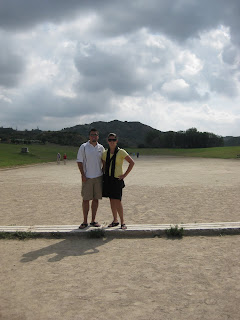
Sunday, June 20th, 2010
We had only a short drive across town from our hotel to the archeological site of Olympia this morning where we began our tour. The ancient town of Olympia was built on the Southern slope of Chronos Hill and was buried in 7-50 meters of sand before it was excavated by the Germans. The ancient town of Olympia has two main sections, a religious section containing the Temple of Zeus, the Temple Hera, and other similar structures, and a secular section which included buildings such as the gymnasium where athletes practiced for foot races, javelin, and discus throw, as well as the Palestra, where athletes were oiled and massaged before entering the gymnasium, and where they were powdered and bathed after they completed their training, and the Bouleuterion which was the meeting building of the Olympic Council, where athletes and judges took the sacred oath before each Olympic games. Olympia’s most famous site however, is of course its stadium, site of the first Olympic Games. The stadium at Olympia was constructed in the 5th century B.C., and did not have seats, other than those for the judges, spectators simply sat along the banks of the stadium. The stadium’s capacity is about 45,000 and the stadium is approximately 193 meters long. Free men of any nation were allowed to watch the games, but only free Greek men were allowed to participate in the ancient Olympic Games, the priestess of the Goddess Hera was the only woman allowed to watch the games. All of the events were held at the stadium at Olympia with the exception of horse and chariot racing, which were held at the hippodrome, which has yet to be discovered. Later, women started their own games in honor of the Goddess Hera; the women’s game had only one event, a foot race of half the length of the stadium.
There are three legends around the starting of the Olympics. The first legend states that King Eramos was told by the oracle at Delphi that he would be killed by his son-in-law. So in order to prevent this fate, the King decided to find a way to get rid of any man who may marry his daughter. He did so by challenging each of her suitors to a chariot race, with the catch that the loser must end his life. Eramos always won. That is until Prince Pelops, son of Poseidon, came to vie for the princess’s hand. Pelops arrived with his golden chariot with four winged horses and defeated the King, took the princess as his bride and inherited the Kingdom, and then in order to give thanks to the Gods, he organized a foot race, which turned into the Olympic Games.
The next legend goes that Chronos and Rhea had 11 kids, but each time Rhea gave birth, Chronos swallowed the child. Finally, when Rhea was about to give birth to her 12th child, she decided to trick Chronos, and handed him a rock swaddled in cloth instead of the child. Chronos swallowed what he thought was the child and laid down for his nap. Rhea then delivered the child and presented him to two sailors who took the child to Crete to raise him. Zeus grew up and confronted his father, asking him to give back his brothers and sisters, and Chronos complied, thus Zeus is considered the father of all Gods since he gave re-birth to his brothers and sisters. Zeus chose Mount Olympus as his dwelling, but would descend to Earth to watch the games that the two sailors had organized to thank Zeus for the re-birth of the Gods.
The final legend says that Hercules had been asked by Hera to measure the length for the stadium. Hercules’s feet are bigger than any other feet. Hence why the stadium at Olympia is bigger than any other such stadiums. So, when asked to measure the stadium, Hercules arranged a foot race in order to do so. This foot race then turned into the Olympic Games.
The ancient games ceased with Christian Rule in the 4th century A.D. The games were not restarted until 1896. Then in 1936 Berlin was hosting the Olympics, and because of their close ties to Olympia in Greece, wanted to create a link between the site of Olympia and the Olympic Games in their country. Thus started the tradition of the Olympic torch, which is lit each year at Hera’s Alter in Olympia, then taken to the stadium at Olympia where the runners are waiting to escort it first all over Greece, and then all over the World.
After touring the rest of the archeological site we walked over to the museum of Olympia where we saw many of the statues, pottery, and other findings from the site before our lunch break.
After lunch we got back on the bus for a few hours trip to Delphi. Upon our arrival in Delphi we toured the museum before turning in for the night at our hotel. Tomorrow we explore the ruins of Delphi.

No comments:
Post a Comment